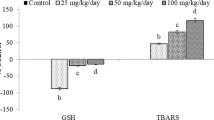Abstract.
Benzanthrone (BA) and 3-bromobenzanthrone (3-BBA) are important dye intermediates used in the manufacture of various vat and disperse dyes. BA has been implicated as a cause of hepatic malfunctions and dermal lesions in workers. However, not much information on halogenated BAs, especially 3-BBA, is available. Experiments were designed to undertake a comparative safety assessment of both BA and 3-BBA, given orally at a dose of 50 mg/kg body weight for 10 days to guinea pigs. There was a significant decrease (25%) in body weight with 3-BBA, whereas BA treatment did not cause any change. Serum glutamate oxaloacetate transaminase and glutamate pyruvate transminase were found to be significantly (P<0.05) increased in 3-BBA- as well as in BA-treated animals. 3-BBA and BA led to substantial depletion of ascorbic acid in both liver and adrenal glands. However, depletion of ascorbic acid was more pronounced with 3-BBA (19.2–28.3%) than with BA (13.5–16.6%). 3-BBA and BA treatments caused 80% and 24% depletion of hepatic free sulfydryl content, while lipid peroxidation showed a significant enhancement of 73% and 47%, respectively. BA and 3-BBA caused decreases in cytochrome P-450 content and phase I enzymes particularly ethoxyresorufin-O-deethylase and aryl hydrocarbon hydroxylase, whereas phase II enzymes (quinone reductase and glutathione-S-transferase) were substantially increased. Activities of bio-antioxidant enzymes, viz., glutathione peroxidase, glutathione reductase, superoxide dismutase and catalase, were significantly increased by 153, 104, 20 and 67% in the 3-BBA-treated group, whereas the degree of increase in these parameters was relatively less in BA-treated group. The data indicate that both BA and 3-BBA can disturb membrane integrity by decreasing endogenous glutathione and ascorbic acid levels with a concomitant increase in lipid peroxidative damage. This may in turn lead to impairment of hepatic P-450-dependent monooxygenase, while the changes in antioxidant enzymes reveal oxidative stress. 3-BBA treatment caused dilation of portal triad with thickening of arterial wall, hyperplasia of Kupffer cells and influx of inflammatory cells between hepatic cords, which could be due to formation of Br• radical or due to formation of semiquinone type of intermediate following oxidation. The results may be interpreted to mean that industrial workers exposed to 3-BBA are at higher risk than those exposed to BA, and necessary precautions should be taken to safeguard their exposure risks.
Similar content being viewed by others
Author information
Authors and Affiliations
Additional information
Electronic Publication
Rights and permissions
About this article
Cite this article
Singh, R.P., Khanna, R., Kaw, J.L. et al. Comparative effect of benzanthrone and 3-bromobenzanthrone on hepatic xenobiotic metabolism and anti-oxidative defense system in guinea pigs. Arch Toxicol 77, 94–99 (2003). https://doi.org/10.1007/s00204-002-0396-9
Received:
Accepted:
Issue Date:
DOI: https://doi.org/10.1007/s00204-002-0396-9




